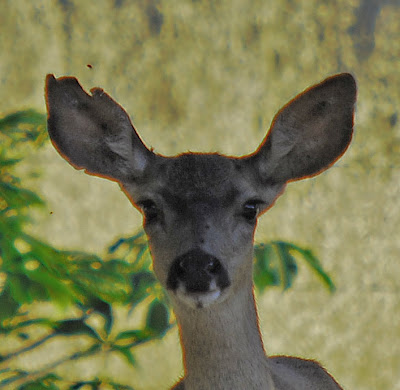 --- Fly, a doe with several cuts on her right ear ---
--- Fly, a doe with several cuts on her right ear ---This is the second in a series about summer deer families on the Dipper Ranch.
FLY - this doe has 2 cuts on the inside of her right ear and a small one on the outside of the same ear. She has one fawn, SQUIRT, with a stumpy nose. Squirt seems smaller than Dot 1 and Dot 2, so maybe its nose will unwrinkle with time. So far, these two families have not mixed, so I haven't been able to compare sizes directly.In a Montana study, pregnant mule deer does carried twin fawns 55%, single fawns 44%, and triplet fawns 1% of the time on average over 12 years. Mule deer does in their first year of adulthood are more likely to carry a single fetus than twins, so perhaps Fly is a young doe. The reproductive potential of a doe is primarily influenced by her nutritional status in the year before the birth, especially in the last 2 to 3 months of pregnancy (Feldhamer, et al.).
Fly is flighty. She bolts quickly, even at the sound of water running in the bathroom sink. Squirt has a hard time keeping up with her during her quick retreats, although the fawn steadily follows her path through the tall grass. One night, I saw Squirt catch up with Fly at a fence line. Fly folded her forelegs and ducked her head under the bottom strand. As Fly's long, flexible back swept low, and her rear legs folded to the ground, tiny Squirt stepped right through the bottom gap in the old fence, and caught up as the doe unfolded her body accordion-like on the other side of the wire.
I often see Fly and Squirt creep out of the willow thicket west of the house at dusk. When the plums were dropping, Fly would stand drooling in the orchard as she ate unripe fruit. I usually didn't see Squirt during her orchard visits. The small fawn might have been screened by the tall grass, but I think Fly tucks Squirt into a nearby stand of canyon live oaks while she wanders about.
PUCK - on occasion, I see another young buck, Puck, with velvety, unbranched antlers about 4" long. I have not detected him as part of any of the other families and have not been able to photograph him yet.
I don't see many bucks this time of year. I did see one with 3 tines on his left antler and 2 tines on the right in early July in the John Deere meadow. The does with fawns have claimed the high ground near the farmyard with more regular water and a variety of food choices, and the bucks are lower down along the forest edges.
At other times of the year, the deer mingle together in mixed herds. They often browse as a herd in the early morning and evening. When the calves first arrived on the Dipper Ranch in January, the deer initially disappeared, but within a few weeks, deer and cattle were sharing the pastures. Both cattle and deer are ruminants or cud-chewers. In the first two chambers of their stomach, the fiborous cellulose of their plant food is partially broken down by symbiotic bacteria. When the ruminants bed down, they regurgitate the cud, chew and mix it with more bile, and then reswallow it to be further digested and absorbed in the other two chambers of the stomach.
Mule deer have a relatively short gut length for their body size compared to other ruminants. Thus, they tend to be selective and eat smaller volumes of food such as young, tender twig tips, leaf buds and other plant tissues which are of higher nutritional quality and easily digested. I've also noticed that deer tend to sample the outside tips of whatever is newly growing along their regular trails. Cattle, on the other hand, will eat and process large quantities of grass and don't sample as much from the woody plants. One study found that Columbian black-tailed deer eat as much as 62% newly germinated annual grasses in the winter in the oak woodland/annual grass ranges of northern California (Feldhamer, et al.). Moderate, seasonal grazing at the Dipper Ranch seems to accommodate both the deer and cattle.
black along the entire length of its dorsal side.
In the background, cattle are chewing their cud.---
See also:
- Wild Mammals of North America, George A. Feldhamer, Bruce C. Thompson, and Joseph A. Chapman, editors, John Hopkins University Press, 2003.




At Arastradero, we saw that while deer were fanatical about willow shoots, they were also quite helpful in keeping down various mustards, especially Hirschfeldia incana. That's a perennials, so browsing doesn't necessarily kill it, but at least it prevents seed spread. The deer would show up en masse at sundown, and I would cheer them on (quietly) 'go on, eat the weeds! leave the willows!'
ReplyDelete